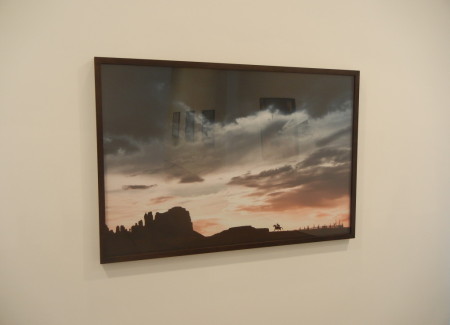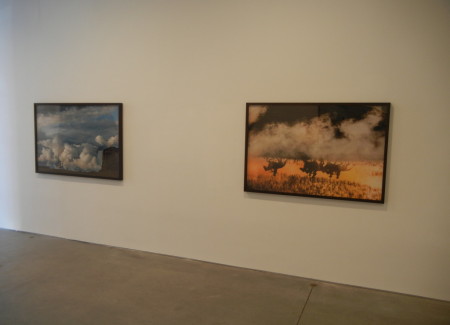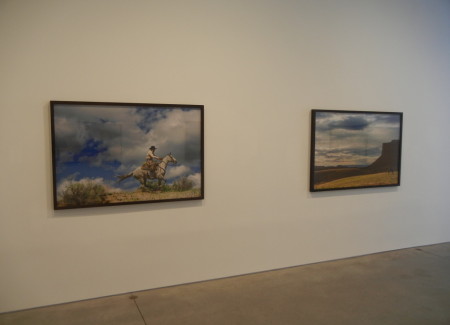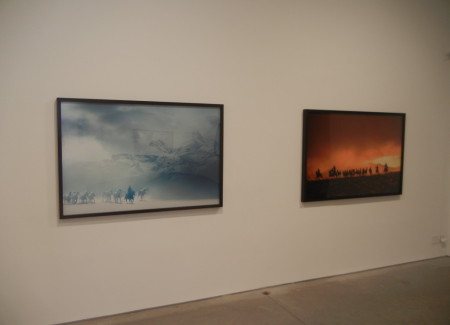JTF (just the facts): A total of 14 large-scale color photographs, framed in black wood and unmatted, and hung against white walls in the two main rooms of the gallery, with one image featured on the partition facing 23rd Street. All of the works are c-prints, made between 2009-2011. The works are printed in three sizes: one is 36×72 inches, three are 32×48 inches, and the remaining ten are 40×60 inches. Each image is available in an edition of 7. (Installation shots below.)
Comments/Context: Jim Krantz’s career exemplifies the abyss that has opened up between the worlds of commercial photography and contemporary art.
A student of Ansel Adams and Paul Caponigro who has applied the technical skills they taught him to advertising, Krantz has done campaigns for dozens of corporations, from Hellman’s mayonnaise and Red Bull to Nokia and Wells Fargo, as well as for the Washington, D.C. tourist board and the U.S. Army.
His photographs are most recognized in art circles, however, for being re-photographed by Richard Prince. The Pictures Generation artist began reshooting advertising images from magazines in 1975 and found a tempting target for his cultural subversions in the “Marlboro Man.” The crafty success of the Western cowboy in selling cigarettes to men and boys can be measured by the fact that by the time Prince decided to appropriate its iconography in 1979, the campaign was already 25 years old. (The Leo Burnett Agency in Chicago introduced the studly character in 1954.) By the timelines of advertising, which routinely changes figures and messages every couple of seasons, such longevity makes the Marlboro Man practically ageless.
Prince began his series with one of Sam Abell’s photographs of a cowboy and by the 1990s was re-photographing Krantz’s, without his knowledge. Upon finding out, he was gracious enough not to pursue a lawsuit. After seeing Prince’s retrospective in 2007 at the Guggenheim, where one of Krantz’s photographs had been re-photographed and displayed outside the museum as a banner—an overhead shot of a faceless cowboy, his Stetson cleanly brushed, one hand resting on a post in the corral, the other holding a freshly lighted cigarette—Krantz told the New York Times, “I didn’t know if I should be proud, or if I looked like an idiot.”
Of course, one reason that Krantz must have thought twice about consulting a lawyer is that his photographs of cowboys are themselves hardly “original.” The image of men galloping their horses across wide open spaces or confidently at ease in the saddle goes back at least to Remington’s paintings and drawings, reproduced by Harper’s Weekly in the 1880s. From there, the myth of solitary horsemen as rugged as the American landscape was transmitted through the lenses of countless Hollywood Westerns, sometimes by cinematographers and directors of genius and, more often, by journeymen or hacks.
Krantz is thus a re-photographer himself, one of the points that Prince’s cunning reproductions underscore. In his own broader way, so was Ansel Adams a re-photographer, of Bierstadt and Moran and Watkins and Muybridge. Pictures evolve from earlier pictures, even as every photograph has somewhere engrained in it evidence of a unique moment.
This is not the place to re-litigate the ethics of appropriation or to tease out its many shades of intent and meaning. The history of worshipful imitation or outright theft precedes Duchamp who nonetheless gave it unprecedented spin, momentum and prestige. An homage can always be interpreted as a failure of imagination.
This exhibition offers proof that Krantz, surprisingly, rather than feeling mocked or shamed by Prince and questioning the myth of the cowboy, has continued to mine this lucrative commercial vein. The sunsets are rich as copper, the ranch-hands slender as Ralph Lauren models, the horses as stoic about their work as the men who guide them through blinding snowstorms. Judging from the prices and the uncritical attitude toward the grim lives of today’s cowboys, these panoramic prints are bound for the living rooms of ski lodges in Jackson Hole and Vail or for man caves at would-be Playboy mansions.
No one should feel sorry for Krantz. Photography has been so good to him that after being based for many years in Chicago, he now lives in Malibu. But his photographs haven’t been as rewarding for him as they have been for Prince. For badly copying images by Krantz and Abell and leaching off their strenuous efforts and expertise, he can now command prices over $3 million. His re-photographs are enshrined as “art,” while Krantz’s photographs are something else.
Prince would never claim that he has the technical know-how to achieve what Krantz does for his clients. The Pictures Generation artists belong to what the English wiseacre Simon Doonan has called the “post-skill” movement. Shows like this demonstrate the shortcomings of appropriation, its parasitic ecology and passive-aggressive temperament. At the same time the cultural necessity and purgative value of artists like Prince and Sherrie Levine is made clearer when the motives of the host are exposed. Even without the Marlboro logo, and though it wasn’t Krantz who directly got teenagers around the world addicted to a deadly product, these calculating photographs of the American pastoral, celebratory of working lives enjoyed in the open air, are anything but innocent.
Collector’s POV: The works in this show are priced as follows. The three monochrome prints are priced at $9500 while the color prints range from $12500 to $18000. Krantz’ work has little secondary market history (under his own name), so gallery retail remains the best option for those collectors interested in following up.













Kitsch versus appropriation. Hm.
Sam Abell gives his thoughts on ‘the life of a photograph’, as mentioned above his were also filched by Richard Prince:
https://www.youtube.com/watch?v=Um74DKYlta8
As much as I feel for him in his (barely concealed) pain and anger I personally would get little or nothing from seeing his work on a gallery wall whereas Prince was audacious and gave those images a vastly more meaningful second life. It’s like they died and went to heaven. They do exist in two seperate cultural universes, linked by a wormhole – incidentally proving Stephen Hawking was right about everything after all. They look the same but relocated from the background blur of everyday life to MOMA they read totally differently. Prince had the vision to see that possibility – and yes there is a ‘purgative value’ in there (great phrase).
Personally I don’t feel Abell or Krantz in reiterating tropes of western mythology transgressed in the same way as Prince did – their brief was to go and make beautiful new images of the idea and that’s exactly what they achieved. I dunno if those who went before would be fuming at their cheek but rather applauding them (for being a sharpshooter and quick on the draw). There should probably be an analogy to real guns and replicas at this point but I’ll leave it at that.
Thanks, RW.
Pete